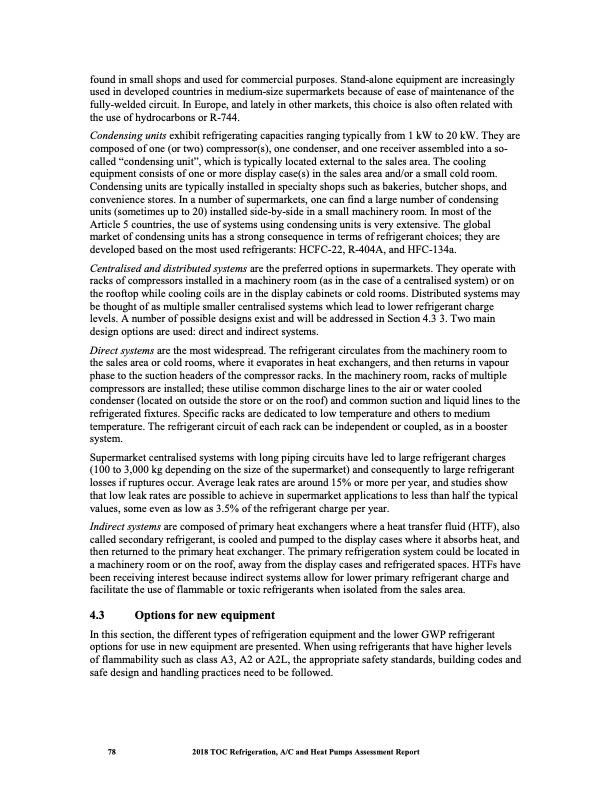
PDF Publication Title:
Text from PDF Page: 091
found in small shops and used for commercial purposes. Stand-alone equipment are increasingly used in developed countries in medium-size supermarkets because of ease of maintenance of the fully-welded circuit. In Europe, and lately in other markets, this choice is also often related with the use of hydrocarbons or R-744. Condensing units exhibit refrigerating capacities ranging typically from 1 kW to 20 kW. They are composed of one (or two) compressor(s), one condenser, and one receiver assembled into a so- called “condensing unit”, which is typically located external to the sales area. The cooling equipment consists of one or more display case(s) in the sales area and/or a small cold room. Condensing units are typically installed in specialty shops such as bakeries, butcher shops, and convenience stores. In a number of supermarkets, one can find a large number of condensing units (sometimes up to 20) installed side-by-side in a small machinery room. In most of the Article 5 countries, the use of systems using condensing units is very extensive. The global market of condensing units has a strong consequence in terms of refrigerant choices; they are developed based on the most used refrigerants: HCFC-22, R-404A, and HFC-134a. Centralised and distributed systems are the preferred options in supermarkets. They operate with racks of compressors installed in a machinery room (as in the case of a centralised system) or on the rooftop while cooling coils are in the display cabinets or cold rooms. Distributed systems may be thought of as multiple smaller centralised systems which lead to lower refrigerant charge levels. A number of possible designs exist and will be addressed in Section 4.3 3. Two main design options are used: direct and indirect systems. Direct systems are the most widespread. The refrigerant circulates from the machinery room to the sales area or cold rooms, where it evaporates in heat exchangers, and then returns in vapour phase to the suction headers of the compressor racks. In the machinery room, racks of multiple compressors are installed; these utilise common discharge lines to the air or water cooled condenser (located on outside the store or on the roof) and common suction and liquid lines to the refrigerated fixtures. Specific racks are dedicated to low temperature and others to medium temperature. The refrigerant circuit of each rack can be independent or coupled, as in a booster system. Supermarket centralised systems with long piping circuits have led to large refrigerant charges (100 to 3,000 kg depending on the size of the supermarket) and consequently to large refrigerant losses if ruptures occur. Average leak rates are around 15% or more per year, and studies show that low leak rates are possible to achieve in supermarket applications to less than half the typical values, some even as low as 3.5% of the refrigerant charge per year. Indirect systems are composed of primary heat exchangers where a heat transfer fluid (HTF), also called secondary refrigerant, is cooled and pumped to the display cases where it absorbs heat, and then returned to the primary heat exchanger. The primary refrigeration system could be located in a machinery room or on the roof, away from the display cases and refrigerated spaces. HTFs have been receiving interest because indirect systems allow for lower primary refrigerant charge and facilitate the use of flammable or toxic refrigerants when isolated from the sales area. 4.3 Options for new equipment In this section, the different types of refrigeration equipment and the lower GWP refrigerant options for use in new equipment are presented. When using refrigerants that have higher levels of flammability such as class A3, A2 or A2L, the appropriate safety standards, building codes and safe design and handling practices need to be followed. 78 2018 TOC Refrigeration, A/C and Heat Pumps Assessment ReportPDF Image | Heat Pumps Technical Options

PDF Search Title:
Heat Pumps Technical OptionsOriginal File Name Searched:
RTOC-assessment-report-2018_0.pdfDIY PDF Search: Google It | Yahoo | Bing
CO2 Organic Rankine Cycle Experimenter Platform The supercritical CO2 phase change system is both a heat pump and organic rankine cycle which can be used for those purposes and as a supercritical extractor for advanced subcritical and supercritical extraction technology. Uses include producing nanoparticles, precious metal CO2 extraction, lithium battery recycling, and other applications... More Info
Heat Pumps CO2 ORC Heat Pump System Platform More Info
| CONTACT TEL: 608-238-6001 Email: greg@infinityturbine.com | RSS | AMP |